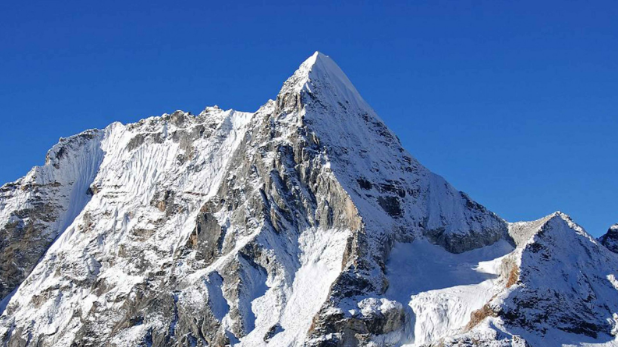Located in the heart of the Khumbu region, surrounded by some of the world’s highest peaks, Mount Baruntse (7,129m / 23,389ft) stands as a spectacular and attainable objective for serious high-altitude climbers. Often overshadowed by its colossal neighbors—Mount Everest, Lhotse, and Makalu—Baruntse offers a unique and compelling challenge. It is widely considered the perfect stepping stone for mountaineers aspiring to climb their first 8,000-meter peak, providing a full-scale expedition experience without the extreme altitude of the “death zone.”
The Appeal of a Classic Alpine Climb
The Baruntse Expedition is a quintessential Himalayan climbing adventure. The standard route, via the Southeast Ridge, presents a balanced combination of trekking and technical climbing. The journey begins with a scenic flight to Lukla, the gateway to the Everest region, and an adventurous trek through the Hinku Valley. This approach is not merely a means to an end; it is a vital part of the expedition, offering a gradual and effective acclimatization process. Many itineraries include an ascent of the popular trekking peak, Mera Peak (6,476m), to further aid in this crucial preparation. This dual-peak approach is a key logistical advantage, maximizing the chances of success on Baruntse.
The trek to Baruntse Base Camp (5,400m) is a feast for the senses, passing through lush forests, high alpine pastures, and past pristine glacial lakes like Seto Pokhari. The remote nature of the region means fewer crowds and a more intimate connection with the untouched wilderness. This is a journey that offers both physical preparation and a rare opportunity for self-reflection and tranquility.
The climb itself is an engaging mix of glacier travel, fixed-rope ascents, and steep snow and ice slopes. The route to Camp I (6,100m) and Camp II (6,400m) involves navigating crevassed glaciers and a demanding headwall leading to the West Col. While not technically extreme, these sections require a solid foundation in mountaineering skills, including the use of crampons, ice axes, and ascenders (jumars). The final summit push is a long, physically demanding day along a majestic, exposed ridgeline, culminating in an awe-inspiring 360-degree panorama of the world’s highest peaks. The views of Everest, Lhotse, Makalu, and Ama Dablam from the summit are arguably among the best in the Himalayas.
Challenges and Preparation: A Commitment to Success
While Baruntse has a high success rate for well-prepared teams, it is by no means an easy climb. The primary challenges are the high altitude, the unpredictable weather, and the physical endurance required for the long summit day.
Acclimatization is the single most important factor for success and safety. Expedition itineraries are carefully designed to include multiple rest days and acclimatization hikes, allowing the body to adapt to the thin air. Proper hydration and nutrition are also essential throughout the entire journey.
Physical Fitness is non-negotiable. Prospective climbers should engage in a rigorous training regimen for several months leading up to the expedition. This should include a combination of cardiovascular endurance (hiking, running), strength training (especially for the legs and core), and carrying a weighted pack. Prior experience with high-altitude trekking or climbing a 6,000-meter peak is a prerequisite for a safe and enjoyable expedition.
Mental Fortitude is equally crucial. The long days, extreme cold, and lack of personal comfort can test a climber’s resolve. The ability to stay positive, patient, and focused, even when faced with setbacks like bad weather or difficult conditions, is a hallmark of a successful expedition member.
The best time for a Baruntse expedition is during the Spring (April-May) and Autumn (October-November) seasons. These periods offer the most stable weather conditions, with clear skies and less risk of heavy snowfall, providing the ideal window for a summit push.
Conclusion
The Baruntse Expedition is a serious undertaking for serious alpinists. It is a journey that rewards commitment, preparation, and a true love for the mountains. It provides the perfect blend of high-altitude trekking and technical climbing, serving as an ideal proving ground for those with their sights set on an 8,000-meter peak. Reaching the summit of Baruntse is not just a personal triumph; it is an unforgettable experience of standing among the greatest mountains on Earth, a memory that will last a lifetime.
Frequently Asked Questions (FAQ)
Q1: How difficult is the Baruntse Expedition?
A1: Baruntse is rated as a “moderately difficult” climb. It is not suitable for beginners and requires previous high-altitude trekking or climbing experience (at least 6,000m). Climbers should be proficient with mountaineering skills and be in excellent physical condition.
Q2: How long does the expedition typically take?
A2: The expedition usually lasts between 25 and 35 days, including travel to and from Kathmandu, the trek to base camp, acclimatization days, and the summit attempt.
Q3: What kind of prior experience do I need?
A3: It is highly recommended that participants have previous experience on high-altitude peaks, such as Mera Peak or Island Peak. You must be comfortable with the use of crampons, ice axes, and fixed-rope techniques.
Q4: What is the best time to go on a Baruntse Expedition?
A4: The most favorable seasons are Spring (April-May) and Autumn (October-November). The weather during these periods is generally more stable, and the temperatures are more manageable for climbing.
Q5: What is the cost of a Baruntse Expedition?
A5: The cost can vary significantly depending on the tour operator, group size, and included services (e.g., full-board vs. basic support). Prices typically range from $8,000 to $13,000 USD per person.

